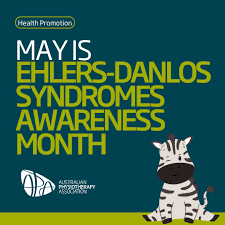Ehlers-Danlos Syndrome Awareness Month
May is dedicated to raising awareness about Ehlers-Danlos Syndromes (EDS), a group of rare genetic connective tissue disorders. The goal is to inform the public, support those affected, encourage understanding, and highlight the importance of early diagnosis and appropriate medical care.

Ehlers-Danlos Syndrome (EDS) is a condition that includes a group of inherited connective tissue disorders. There are at least six different types of EDS, each caused by a different defect in connective tissue. The symptoms vary depending on the type, but all forms share a defect in a structural protein called collagen. Collagen is the primary component of connective tissue and is found throughout the body—in joints, blood vessels, skin, and more. A defect in collagen can lead to a range of symptoms and complications. It provides strength, elasticity, and cohesion between tissues—imagine collagen as the glue that holds everything together. In EDS patients, the strength and regulation of elasticity in the affected tissues is impaired, leading to the characteristic signs and symptoms of the condition.
The most common overall manifestations (though not all may be present, as they depend on the specific type of the condition) include:
- Joints may become overly mobile (joint hypermobility), meaning individuals can bend their joints more than what is considered typical. This hypermobility occurs because the tissues that normally hold the joint firmly in place are now loose due to defective connective tissue. When a joint is loose, it moves more easily, increasing the risk of dislocations and joint instability. Pain can also occur. In later life, premature degenerative changes in the joints may develop. These changes refer to early wear and tear of the joint.
- Skin may be unusually thin and stretchable (elastic), and fragile (more prone to injury), since collagen is an essential component of the skin. When collagen is impaired, the skin loses its strength. Wound healing may be delayed, and bruising often occurs very easily.
- Blood vessels and the heart – issues with blood vessels are especially pronounced in the vascular type of EDS. Since collagen is a key structural component of blood vessels, its defect reduces their strength. This leads to an increased risk of blood vessel rupture, and individuals may experience problems with large blood vessels in the body (such as aortic dissection and aneurysm), which can be life-threatening. Some types of EDS can also involve problems with heart valves.
- Other systems that may be affected include the digestive system (where fragile connective tissue in the intestines can more easily rupture), the urinary system, teeth, and the spine (e.g., scoliosis).

Ehlers-Danlos Syndrome Awareness Month is dedicated to educating the public and healthcare professionals, supporting those affected, encouraging scientific research, and reducing the stigma and misunderstanding often faced by individuals living with EDS.

This content was created with the financial support of the Ministry of Health. The content of this document is the sole responsibility of the Croatian Alliance for Rare Diseases and under no circumstances can it be considered as reflecting the views of the Ministry of Health.

